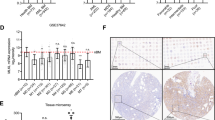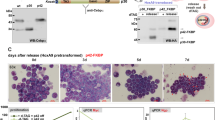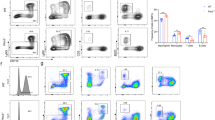Abstract
Deregulated growth and blocks in differentiation collaborate in the multistage process of leukemogenesis. Previously, we have shown that ectopic expression of the zinc finger transcription factor Egr-1 in M1 myeloblastic leukemia cells promotes terminal differentiation with interleukin-6 (IL-6). In addition, we have shown that deregulated expression of the oncogene E2F-1 blocks the myeloid terminal differentiation program, resulting in proliferation of immature cells in the presence of IL-6. Here it is shown that the positive regulator of differentiation Egr-1 abrogates the E2F-1-driven block in myeloid terminal differentiation. The M1E2F-1/Egr-1 cells underwent G0/G1 arrest and functional macrophage maturation following treatment with IL-6. Furthermore, Egr-1 diminished the aggressiveness of M1E2F-1 leukemias and abrogated the leukemic potential of IL-6-treated M1E2F-1 cells. Previously, we reported that Egr-1 abrogated the block in terminal myeloid differentiation imparted by deregulated c-myc, which blocks differentiation at a later stage than E2F-1, resulting in cells that have the characteristics of functionally mature macrophages that did not undergo G0/G1 arrest. Taken together, this work extends and highlights the tumor suppressor role of Egr-1, with Egr-1 behaving as a tumor suppressor against two oncogenes, each blocking myeloid differentiation by a different mechanism. These findings suggest that Egr-1 and/or Egr-1 target genes may be useful tools to treat or suppress oncogene-driven hematological malignancies.
This is a preview of subscription content, access via your institution
Access options
Subscribe to this journal
Receive 50 print issues and online access
$259.00 per year
only $5.18 per issue
Buy this article
- Purchase on Springer Link
- Instant access to full article PDF
Prices may be subject to local taxes which are calculated during checkout







Similar content being viewed by others
References
Amanullah A, Hoffman B, Liebermann DA . (2000). Deregulated E2F-1 blocks terminal differentiation and loss of leukemogenicity of M1 myeloblastic leukemia cells without abrogating induction of p15INH4B and p16INK4A. Blood 96: 475–482.
Baron V, De Gregorio G, Krones-Herzig A, Virolle T, Calogero A, Urcis R et al. (2003). Inhibition of Egr-1 expression reverses transformation of prostate cancer cells in vitro and in vivo. Oncogene 22: 4194–4204.
Beckmann AM, Wilce PA . (1992). Egr transcription factors in the nervous system. Neurochem Int 31: 477–510.
Bram S, Rodjer S, Swolin B . (2004). Several chromosomes involved in translocation with chromosome 5 shown with fluorescence in situ hybridization in patients with malignant myeloid disorders. Cancer Genet Cytogenet 155: 74–78.
Carter JH, Tourtellotte WG . (2007). Early growth response transcriptional regulators are dispensable for macrophage differentiation. J Immunol 178: 3038–3047.
Chen F, Wang Q, Wang X, Studzinski GP . (2004). Up-regulation of Egr-1 by 1, 25-dihydroxyvitamin D3 contributes to increased expression of p35 activator of cyclin-dependent kinase 5 and consequent onset of the terminal phase of HL60 cell differentiation. Cancer Res 64: 5425–5433.
Giagounidis AA, Germing U, Haase S, Hildebrandt B, Schlegelberger B, Schoch C et al. (2004). Clinical morphological, cytogenetic, and prognostic features of patients with myelodysplastic syndromes and del (5q) including band q31. Leukemia 18: 113–119.
Hoffman B, Amanullah A, Shafarenko M, Liebermann DA . (2002). The proto-oncogene c-myc in hematopoietic development and leukemogenesis. Oncogene 21: 3414–3421.
Hoffman-Liebermann B, Liebermann DA . (1991). Interleukin-6 and leukemia inhibitory factor-induced terminal differentiation of myeloid leukemia cells is blocked at an intermediate stage by constitutive c-myc. Mol Cell Bio 11: 2375–2381.
Krishnaraju K, Hoffman B, Liebermann DA . (1998). The zinc finger transcription factor Egr-1 activates macrophage differentiation in M1 myeloblastic leukemia cells. Blood 92: 1957–1966.
Krishnaraju K, Hoffman B, Liebermann DA . (2001). Early growth response gene 1 stimulates development of hematopoietic progenitor cells along the macrophage lineage at the expense of the granulocyte and erythroid lineages. Blood 97: 1298–1305.
Krishnaraju K, Nguyen HQ, Liebermann DA, Hoffman B . (1995). The zinc finger transcription factor Egr-1 potentiates macrophage differentiation of hematopoietic cells. Mol Cell Biol 15: 5499–5507.
Laslo P, Spooner CJ, Warmflash A, Lancki DW, Lee HJ, Sciammas R et al. (2006). Multilineage transcriptional priming and determination of alternate hematopoietic cell fates. Cell 126: 755–766.
Liu C, Yao J, de Belle I, Huang RP, Adamson E, Mercola D . (1999). The transcription factor Egr-1 suppresses transformation of human fibrosarcoma HT1080 cells by coordinated induction of transforming growth factor-beta 1, fibronectin, and plasminogen activator inhibitor-1. J Biol Chem 274: 4400–4411.
McMahon SB, Monroe JG . (1996). The role of early growth response gene1 (egr-1) in regulation of the immune response. J Leukoc Biol 60: 159–166.
Nguyen HQ, Hoffman-Liebermann B, Liebermann DA . (1993). The zinc finger transcription factor Egr-1 is essential for and restricts differentiation along the macrophage lineage. Cell 72: 197–209.
Selvakumaran M, Liebermann DA, Hoffman-Liebermann B . (1992). Deregulated c-myb disrupts interleukin-6 or leukemia inhibitory factor-induced myeloid differentiation prior to c-myc: role in leukemogenesis. Mol Cell Biol 12: 2493–2500.
Shafarenko M, Liebermann DA, Hoffman B . (2005). Egr-1 abrogates the block imparted by c-Myc on terminal M1 myeloid differentiation. Blood 106: 871–878.
Steinkamp JA, Wilson JS, Saunders GC, Stewart CC . (1982). Phagocytosis: flow cytometric quantitation with fluorescent microspheres. Science 215: 64–66.
Acknowledgements
We thank Dr Arthur Balliet for his guidance in the FACS/Imaging and other technical insights. This work was supported by a grant from the National Institutes of Health (RO1 CA081168) to BH.
Author information
Authors and Affiliations
Corresponding author
Additional information
Supplementary Information accompanies the paper on the Oncogene website (http://www.nature.com/onc).
Supplementary information
Rights and permissions
About this article
Cite this article
Gibbs, J., Liebermann, D. & Hoffman, B. Egr-1 abrogates the E2F-1 block in terminal myeloid differentiation and suppresses leukemia. Oncogene 27, 98–106 (2008). https://doi.org/10.1038/sj.onc.1210627
Received:
Revised:
Accepted:
Published:
Issue Date:
DOI: https://doi.org/10.1038/sj.onc.1210627



